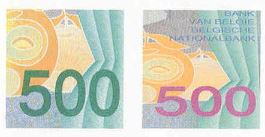2000 BEF
The 2000 Belgian franc note is the second last one in this series, but the last one depicting 19th and 20th century artistst.
This note was among my absolute favourite ones at the time they were in use, and still is.
I do love the colour purple and due to the higher face value at the time (2000 Belgian francs = € 49.58) - I was still young and 2000 francs was still worth some money - the note came rarely in my hands.
Nowadays, € 50 is almost the standard in redrawing money...
 |
| 2000 Belgian franks front - Victor Horta |
Horta was born on January 6, 1861 in Ghent and died in Brussels in 1947.
He was a pioneer of modern architecture and a representative for the Art Nouveau style.
 |
| Horta house and workplace - now museum |
Among his works are many private houses and hotels in Belgium, the first designs for the central station in Brussels, and even the tomb of German composer Johannes Brahms (in Vienna).
Not only was he the leading designer of many houses, he also designed many interior objects, wall and window decorations, in order to make a complete project in the same style.
 |
| Solvay Hotel Brussels |
On the reverse side of the note, we see the curvy flower ornaments that are typical for the art nouveau architecture.
 |
| reverse side of 2000 Belgian francs note |
The idea of bringing nature back into the houses (after the industrial revolution of the end of the 19th century) through flower designs, nymphs, wavy lines, floursish in the early years of the 1900's.
There is hardly a single straight line to be found, unless it is realy necessary.
Opposite to the art deco style (where nature is often more depicted as stylized people, animals, plants and objects, with more geometric shapes and mazes), the art nouveau (or Jugendstil in German - Belle époque in French), is a true roller coaster for the eye.
 |
| Art Nouveau in all its glory |
All of the security features on the previous notes, are also present in this note.
more info : https://www.nbb.be/doc/ts/publications/brochures/2000en.pdf
to be continued...




















